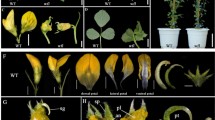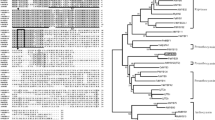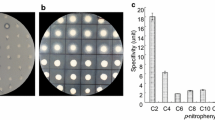Abstract
Main conclusion
This study provides new insights into the biosynthesis regulation and in planta function of the lignan yatein in flax leaves.
Pinoresinol–lariciresinol reductases (PLR) catalyze the conversion of pinoresinol into secoisolariciresinol (SECO) in lignan biosynthesis. Several lignans are accumulated in high concentrations, such as SECO accumulated as secoisolariciresinol diglucoside (SDG) in seeds and yatein in aerial parts, in the flax plant (Linum usitatissimum L.) from which two PLR enzymes of opposite enantioselectivity have been isolated. While LuPLR1 catalyzes the biosynthesis of (+)-SECO leading to (+)-SDG in seeds, the role(s) of the second PLR (LuPLR2) is not completely elucidated. This study provides new insights into the in planta regulation and function of the lignan yatein in flax leaves: its biosynthesis relies on a different PLR with opposite stereospecificity but also on a distinct expression regulation. RNAi technology provided evidence for the in vivo involvement of the LuPLR2 gene in the biosynthesis of (−)-yatein accumulated in flax leaves. LuPLR2 expression in different tissues and in response to stress was studied by RT-qPCR and promoter-reporter transgenesis showing that the spatio-temporal expression of the LuPLR2 gene in leaves perfectly matches the (−)-yatein accumulation and that LuPLR2 expression and yatein production are increased by methyl jasmonate and wounding. A promoter deletion approach yielded putative regulatory elements. This expression pattern in relation to a possible role for this lignan in flax defense is discussed.








Similar content being viewed by others
Abbreviations
- GUS:
-
β-Glucuronidase
- MeJA:
-
Methyl jasmonate
- 4-MUG:
-
4-Methylumbelliferyl-β-d-glucuronide
- PLR:
-
Pinoresinol–lariciresinol reductase
- SA:
-
Salicylic acid
- SDG:
-
Secoisolariciresinol diglucoside
- SECO:
-
Secoisolariciresinol
References
Adlercreutz H (2007) Lignans and human health. Crit Rev Cl Lab Sci 44:483–525
Aloni R, Schwalm K, Langhans M, Ullrich C (2003) Gradual shifts in sites of free-auxin production during leaf-primordium development and their role in vascular differentiation and leaf morphogenesis in Arabidopsis. Planta 216:841–853
Barto EK, Cipollini D (2005) Testing the optimal defense theory and the growth-differentiation balance hypothesis in Arabidopsis thaliana. Oecologia 146:169–178
Berim A, Spring O, Conrad J, Maitrejean M, Boland W, Petersen M (2005) Enhancement of lignan biosynthesis in suspension cultures of Linum nodiflorum by coronalon, indanoyl-isoleucine and methyl jasmonate. Planta 222:769–776
Bomal C, Bedon F, Caron S, Mansfield SD, Levasseur C, Cooke JE, Blais S, Tremblay L, Morency MJ, Pavy N, Grima-Pettenati J, Séguin A, Mackay J (2008) Involvement of Pinus taeda MYB1 and MYB8 in phenylpropanoid metabolism and secondary cell wall biogenesis: a comparative in planta analysis. J Exp Bot 59:3925–3939
Burlat V, Kwon M, Davin LB, Lewis NG (2001) Dirigent proteins and dirigent sites in lignifying tissues. Phytochemistry 57:883–897
Chang W-C, Lee T-Y, Huang H-D, Huang H-Y, Pan R-L (2008) PlantPAN: plant promoter analysis navigator, for identifying combinatorial cis-regulatory elements with distance constraint in plant gene groups. BMC Genom 9:561
Corbin C, Decourtil C, Marosevic D, Bailly M, Lopez T, Renouard S, Doussot J, Dutilleul C, Auguin D, Giglioli-Guivarc’h N, Lainé E, Lamblin F, Hano C (2013a) Role of protein farnesylation events in the ABA-mediated regulation of the Pinoresinol-Lariciresinol Reductase 1 (LuPLR1) gene expression and lignan biosynthesis in flax (Linum usitatissimum L.). Plant Physiol Biochem 72:96–111
Corbin C, Renouard S, Lopez T, Lamblin F, Lainé E, Hano C (2013b) Identification and characterization of cis-acting elements involved in the regulation of ABA- and/or GA-mediated LuPLR1 gene expression and lignan biosynthesis in flax (Linum usitatissimum L.) cell cultures. J Plant Physiol 170:516–522
Dalisay DS, Kim KW, Lee C, Yang H, Rübel O, Bowen BP, Davin LB, Lewis NG (2015) Dirigent protein-mediated lignan and cyanogenic glucoside formation in flax seed: integrated omics and MALDI mass spectrometry imaging. J Nat Prod 78:1231–1242
Davin LB, Lewis NG (2003) An historical perspective on lignan biosynthesis: monolignol, allylphenol and hydroxycinnamic acid coupling and downstream metabolism. Phytochem Rev 2:257–288
Davin LB, Wang H-B, Crowell AL, Bedgar DL, Martin DM, Sarkanen S, Lewis NG (1997) Stereoselective bimolecular phenoxy radical coupling by an auxiliary (Dirigent) protein without an active center. Science 275:362–367
Debeaujon I, Koornneef M (2000) Gibberellin requirement for Arabidopsis seed germination is determined both by testa characteristics and embryonic abscisic acid. Plant Physiol 122:415–424
Devic M, Albert S, Delseny M, Roscoe TJ (1997) Efficient PCR walking on plant genomic DNA. Plant Physiol Biochem 35:1–9
Doussot J, Mathieu V, Colas C, Molinié R, Corbin C, Montguillon J, Moreno Y Banuls L, Renouard S, Lamblin F, Dupré P, Maunit B, Kiss R, Hano C, Lainé E (2017) Investigation of the lignan content in extracts from Linum, Callitris and Juniperus species in relation to their in vitro antiproliferative activities. Planta Med (in press)
Doyle J, Doyle J (1990) Isolation of plant DNA from fresh tissue. Focus 12:13–15
Ford JD, Huang KS, Wang HB, Davin LB, Lewis NG (2001) Biosynthetic pathway to the cancer chemopreventive secoisolariciresinol diglucoside-hydroxymethyl glutaryl ester-linked lignan oligomers in flax (Linum usitatissimum) seed. J Nat Prod 64:1388–1397
Ghose K, Selvaraj K, McCallum J, Kirby CW, Sweeney-Nixon M, Cloutier SJ, Deyholos M, Datla R, Fofana B (2014) Identification and functional characterization of a flax UDP-glycosyltransferase glucosylating secoisolariciresinol (SECO) into secoisolariciresinol monoglucoside (SMG) and diglucoside (SDG). BMC Plant Biol 14:82
Goodstein DM, Shu S, Howson R, Neupane R, Hayes RD, Fazo J, Mitros T, Dirks W, Hellsten U, Putnam N, Rokhsar DS (2012) Phytozome: a comparative platform for green plant genomics. Nucleic Acids Res 40:D1178–D1186
Han Y, Zhou Z, Wu H, Nie H, Lei R, Bai Y, Liu H (2012) Simultaneous determination of jasmonic acid epimers as phytohormones by chiral liquid chromatography-quadropole time-of-flight mass spectrometry and their epimerization study. J Chromatogr A 1235:125–131
Hano C, Martin I, Fliniaux O, Legrand B, Gutierrez L, Arroo RRJ, Mesnard F, Lamblin F, Lainé E (2006) Pinoresinol-lariciresinol reductase gene expression and secoisolariciresinol diglucoside accumulation in develo** flax (Linum usitatissimum) seeds. Planta 224:1291–1301
Harmatha J, Dinan L (2003) Biological activities of lignans and stilbenoids associated with plant-insect chemical interactions. Phytochem Rev 2:321–330
Harms K, Atzorn R, Brash A, Kuhn H, Wasternack C, Willmitzer L, Pena-Cortes H (1995) Expression of a flax allene oxide synthase cDNA leads to increased endogenous jasmonic acid (JA) levels in transgenic potato plants but not to a corresponding activation of JA-responding genes. Plant Cell 7:1645–1654
Hemmati S, von Heimendahl CBI, Klaes M, Alfermann AW, Schmidt TJ, Fuss E (2010) Pinoresinol-lariciresinol reductases with opposite enantiospecificity determine the enantiomeric composition of lignans in the different organs of Linum usitatissimum L. Planta Med 76:928–934
Hoagland DR, Arnon DI (1938) The water culture method for growing plants without soil. Calif Agr Exp Sta Cir 347:32
Holmbom B, Eckerman C, Eklund P, Hemming J, Nisula L, Reunanen M, Sjöholm R, Sundberg A, Sundberg K, Willför S (2003) Knots in trees: a new rich source of lignans. Phytochem Rev 2:331–340
Huis R, Hawkins S, Neutelings G (2010) Selection of reference genes for quantitative gene expression normalization in flax (Linum usitatissimum L.). BMC Plant Biol 10:71
Huis R, Morreel K, Fliniaux O, Lucau-Danila A, Fénart S, Grec S, Neutelings G, Chabbert B, Mesnard F, Boerjan W, Hawkins S (2012) Natural hypolignification is associated with extensive oligolignol accumulation in flax stems. Plant Physiol 158:1893–1915
Jefferson RA, Kavanagh TA, Bevan MW (1987) GUS fusions: beta-glucuronidase as a sensitive and versatile gene fusion marker in higher plants. EMBO J 6:3901–3907
Joshi CP, Zhou H, Huang X, Chiang VL (1997) Context sequences of translation initiation codon in plants. Plant Mol Biol 35:993–1001
Kagaya Y, Ohmiya K, Hattori T (1999) RAV1, a novel DNA-binding protein, binds to bipartite recognition sequence through two distinct DNA-binding domains uniquely found in higher plants. Nucleic Acids Res 27:470–478
Karimi M, Inzé D, Depicker A (2002) GATEWAYTM vectors for Agrobacterium -mediated plant transformation. Trends Plant Sci 7:193–195
Kim MK, Jeon J-H, Fujita M, Davin LB, Lewis NG (2002) The western red cedar (Thuja plicata) 8–8′ DIRIGENT family displays diverse expression patterns and conserved monolignol coupling specificity. Plant Mol Biol 49:199–214
Kitts DD, Yuan YV, Wijewickreme AN, Thompson LU (1999) Antioxidant activity of the flaxseed lignan secoisolariciresinol diglycoside and its mammalian lignan metabolites enterodiol and enterolactone. Mol Cell Biochem 202:91–100
Kogushi S, Ohashi Y, Nakajima K, Arai Y (1990) An improved assay for β-glucuronidase in transformed cells: methanol almost completely suppresses a putative endogenous β-glucuronidase activity. Plant Sci 70:133–140
Kunkel BN, Brooks DM (2002) Cross talk between signaling pathways in pathogen defense. Curr Opin Plant Biol 5:325–331
Kwon M, Davin LB, Lewis NG (2001) In situ hybridization and immunolocalization of lignan reductases in woody tissues: implications for heartwood formation and other forms of vascular tissue preservation. Phytochemistry 57:899–914
Lacoux J, Duval I, Dupré P, Gutierrez L, Lesueur S, Roger D, Lainé E (2003) Activity of a flax pectin methylesterase promoter in transgenic tobacco pollen. J Plant Physiol 160:977–979
Leon-Reyes A, Van der Does D, De Lange ES, Delker C, Wasternack C, Van Wees SCM, Ritsema T, Pieterse CMJ (2010) Salicylate-mediated suppression of jasmonate-responsive gene expression in Arabidopsis is targeted downstream of the jasmonate biosynthesis pathway. Planta 232:1423–1432
Lorenzo O, Chico JM, Sánchez-Serrano JJ, Solano R (2004) JASMONATE-INSENSITIVE1 encodes a MYC transcription factor essential to discriminate between different jasmonate-regulated defense responses in Arabidopsis. Plant Cell 16:1938–1950
Lütcke HA, Chow KC, Mickel FS, Moss KA, Kern HF, Scheele GA (1987) Selection of AUG initiation codons differs in plants and animals. EMBO J 6:43–48
MacRae WD, Towers GHN (1984) Biological activities of lignans. Phytochemistry 23:1207–1220
Murashige T, Skoog F (1962) A revised medium for rapid growth and bio assays with tobacco tissue cultures. Physiol Plant 15:473–497
Nakatsubo T, Mizutani M, Suzuki S, Hattori T, Umezawa T (2008) Characterization of Arabidopsis thaliana pinoresinol reductase, a new type of enzyme involved in lignan biosynthesis. J Biol Chem 283:15550–15557
Nishiuchi T, Shinshi H, Suzuki K (2004) Rapid and transient activation of transcription of the ERF3 gene by wounding in tobacco leaves: possible involvement of NtWRKYs and autorepression. J Biol Chem 279:55355–55361
Peterson J, Dwyer J, Adlercreutz H, Scalbert A, Jacques P, McCullough ML (2010) Dietary lignans: physiology and potential for cardiovascular disease risk reduction. Nutr Rev 68:571–603
Quéro A, Molinié R, Elboutachfaiti R, Petit E, Pau-Roblot C, Guillot X, Mesnard F, Courtois J (2014) Osmotic stress alters the balance between organic and inorganic solutes in flax (Linum usitatissimum). J Plant Physiol 171:55–64
Ralph S, Park J-Y, Bohlmann J, Mansfield SD (2006) Dirigent proteins in conifer defense: gene discovery, phylogeny, and differential wound- and insect-induced expression of a family of DIR and DIR-like genes in spruce (Picea spp.). Plant Mol Biol 60:21–40
Renouard S, Corbin C, Lopez T, Montguillon J, Gutierrez L, Lamblin F, Lainé E, Hano C (2012) Abscisic acid regulates pinoresinol–lariciresinol reductase gene expression and secoisolariciresinol accumulation in develo** flax (Linum usitatissimum L.) seeds. Planta 235:85–98
Renouard S, Tribalat MA, Lamblin F, Mongelard G, Fliniaux O, Corbin C, Marosevic D, Pilard S, Demailly H, Gutierrez L, Hano C, Mesnard F, Lainé E (2014) RNAi-mediated pinoresinol lariciresinol reductase gene silencing in flax (Linum usitatissimum L.) seed coat: consequences on lignans and neolignans accumulation. J Plant Physiol 171:1372–1377
Rhoades D, Cates R (1976) Toward a general theory of plant antiherbivore chemistry. In: Wallace JW, Mansell RL (eds) Recent advances in phytochemistry, vol 10., Biochemical interaction between plants and insectsSpringer, US, pp 168–213
Roger D, Lacoux J, Lamblin F, Gaillet D, Dauchel H, Klein D, Balangé AP, David A, Lainé E (2001) Isolation of a flax pectin methylesterase promoter and its expression in transgenic tobacco. Plant Sci 160:713–721
Schmitt J, Petersen M (2002) Influence of methyl jasmonate and coniferyl alcohol on pinoresinol and matairesinol accumulation in a Forsythia × intermedia suspension culture. Plant Cell Rep 20:885–890
Schweiger R, Heise AM, Persicke M, Müller C (2014) Interactions between the jasmonic and salicylic acid pathway modulate the plant metabolome and affect herbivores of different feeding types. Plant Cell Environ 37:1574–1585
Shah J, Klessig DF (1996) Identification of a salicylic acid-responsive element in the promoter of the tobacco pathogenesis-related beta-1,3-glucanase gene, PR-2d. Plant J 10:1089–1101
Tocquin P, Corbesier L, Havelange A, Pieltain A, Kurtem E, Bernier G, Périlleux C (2003) A novel high efficiency, low maintenance, hydroponic system for synchronous growth and flowering of Arabidopsis thaliana. BMC Plant Biol 3:2
Umezawa T (2003) Diversity in lignan biosynthesis. Phytochem Rev 2:371–390
van Fürden B, Humburg A, Fuss E (2005) Influence of methyl jasmonate on podophyllotoxin and 6-methoxypodophyllotoxin accumulation in Linum album cell suspension cultures. Plant Cell Rep 24:312–317
von Heimendahl CBI, Schäfer KM, Eklund P, Sjöholm R, Schmidt TJ, Fuss E (2005) Pinoresinol-lariciresinol reductases with different stereospecificity from Linum album and Linum usitatissimum. Phytochemistry 66:1254–1263
Wang Z, Hobson N, Galindo L, Zhu S, Shi D, McDill J, Yang L, Hawkins S, Neutelings G, Datla R, Lambert G, Galbraith DW, Grassa CJ, Geraldes A, Cronk QC, Cullis C, Dash PK, Kumar PA, Cloutier S, Sharpe AG, Wong GK, Wang J, Deyholos MK (2012) The genome of flax (Linum usitatissimum) assembled de novo from short shotgun sequence reads. Plant J 72:461–473
Wiesenborn D, Tostenson K, Kangas N (2003) Continuous abrasive method for mechanically fractionating flaxseed. J Am Oil Chem Soc 80:295–300
Yamamoto S, Nakano T, Suzuki K, Shinshi H (2004) Elicitor-induced activation of transcription via W box-related cis-acting elements from a basic chitinase gene by WRKY transcription factors in tobacco. BBA-Gene Struc Exp 1679:279–287
Yousefzadi M, Sharifi M, Chashmi NA, Behmanesh M, Ghasempour A (2010) Optimization of podophyllotoxin extraction method from Linum album cell cultures. Pharm Biol 48:1421–1425
Zhao Q, Zeng Y, Yin Y, Pu Y, Jackson LA, Engle NL, Martin MZ, Tschaplinski TJ, Ding SY, Ragauskas AJ, Dixon RA (2014) Pinoresinol reductase 1 impacts lignin distribution during secondary cell wall biosynthesis in Arabidopsis. Phytochemistry 112:170–178
Zhu Q, Dabi T, Lamb C (1995) TATA box and initiator functions in the accurate transcription of a plant minimal promoter in vitro. Plant Cell 7:1681–1689
Acknowledgements
This research was funded by Conseil Départemental d’Eure et Loir, Ligue Contre le Cancer Comité d’Eure et Loir, Région Centre Val de Loire and Ministère Enseignement Supérieur, Recherche et Technologies. We wish to thank JP Trouvé (Coopérative Terre de Lin) for donating seeds. The authors thank Carol Robins (Scientific English) for English editing.
Author information
Authors and Affiliations
Corresponding author
Electronic supplementary material
Below is the link to the electronic supplementary material.
425_2017_2701_MOESM1_ESM.pptx
Online Resource S1 ClustalW alignment of the LuPLR2 gene putative promoter region isolated by chromosome walking and the corresponding sequence deposited in the Phytozome database resulting from the flax genome sequencing project (Wang et al. 2012) (PPTX 55 kb)
425_2017_2701_MOESM2_ESM.pptx
Online Resource S2 Putative cis-acting elements located in the 1,207 nucleotide sequence of the 5’ non-coding region of the LuPLR2 gene detected using the data available on the PlantPAN (PPTX 48 kb)
425_2017_2701_MOESM3_ESM.docx
Online Resource S3 a Comparison of the normalized LuPLR1 and LuPLR2 gene expression measured by RT-qPCR in flax leaves and b during the first seed developmental stages. Developmental stages are described by Hano et al. (2006). WS is for whole seed. Briefly, WS0-1: 4–10 days after flowering, from no visible to 0.5-mm embryo, WS2: 16 days after flowering, from 2- to 3-mm embryo, WS3: 20 days after flowering, from 4- to 5-mm embryo. Data are expressed as the mean of n=4 independent experiments ± standard deviation of the mean (DOCX 29 kb)
Rights and permissions
About this article
Cite this article
Corbin, C., Drouet, S., Mateljak, I. et al. Functional characterization of the pinoresinol–lariciresinol reductase-2 gene reveals its roles in yatein biosynthesis and flax defense response. Planta 246, 405–420 (2017). https://doi.org/10.1007/s00425-017-2701-0
Received:
Accepted:
Published:
Issue Date:
DOI: https://doi.org/10.1007/s00425-017-2701-0




